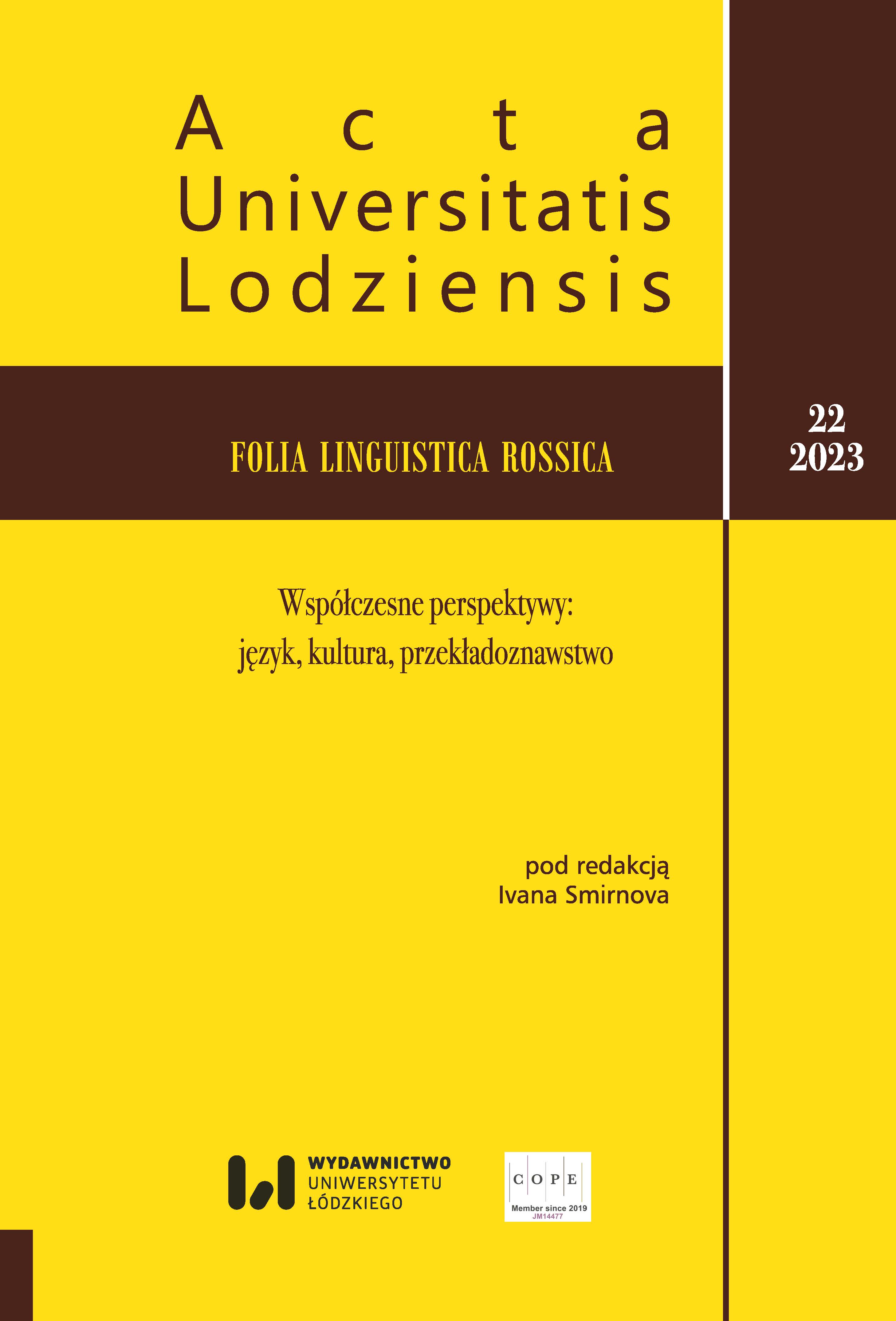Translation of Toponimes as a Problem of Teaching Literary Translation (by the Material of Translations of Students and High School Pupils)
DOI:
https://doi.org/10.18778/1731-8025.22.08Keywords:
translation, toponyms, urbanonyms, translation errors, Russian language, Bulgarian languageAbstract
This article is devoted to the translation of toponyms and the main difficulties that young translators face in this process.
The purpose of this article is to identify some errors in the translation of toponyms and, in particular, their category – urbanonyms (names of intracity objects) from Russian into Bulgarian. This study is carried out on the basis of student translations and translations of high school students.
The main method used in this article is a comparative analysis of the translation with the original at the lexical and semantic levels; the descriptive method and the method of analyzing translation errors from the point of view of their essence and causes are also applied.
The analysis of translations of students made it possible to identify the following errors in the transfer of toponymic names – urbanonyms from Russian into Bulgarian: inaccurate transfer of names included in the category of national-specific realities and abbreviations; non-compliance with the punctuation rules of the Bulgarian language in the spelling of the names of urbanonyms denoting streets, squares, etc.; errors associated with language proficiency at the level of morphology and with the perception of the graphic form of toponyms.
The results of the analysis are relevant for teaching literary translation and will help overcome errors of this type in the process of training young translators.
References
Ангелова, Н. (2003). Нов учебен руско-български и българо-руски речник. Велико Търново: Слово.
Google Scholar
Бархударов, Л.С. (1975). Язык и перевод (Вопросы общей и частной теории перевода). Москва: Международные отношения.
Google Scholar
Басик, С.Н. (2006). Общая топонимика: учебное пособие для студентов географического факультета. Минск: БГУ.
Google Scholar
Васева, И. (1980). Теория и практика перевода. София: Наука и искусство.
Google Scholar
Влахов, С. (2007). Нов руско-български речник. Под редакцията на А. Липовска. Второ преработено и допълнено издание. Cофия: Парадигма.
Google Scholar
Глуховски, Д. (2022). Граничен пост 2. Cофия: Сиела.
Google Scholar
Глуховский, Д. (2021). Пост 2. Спастись и сохранить.
Google Scholar
Карпенко, Ю.А. (1964). О синхронической топонимике. B: Принципы топонимики (50–57). Москва: Наука.
Google Scholar
Мезенко, А.М. (1991). Урбанонимия Белоруссии, Автореф.: дисс... докт. филол. наук. Минск.
Google Scholar
Мурзаев, Э.М. (1982). География в названиях. Москва: Наука.
Google Scholar
Подольская, Н.В. (1990). Ономастическое словообразование (Сопоставительный анализ на материале восточно-славянской онимии), Дисс... докт. филол. наук. Москва.
Google Scholar
Суперанская, А.В. (1973). Общая теория имени собственного. Москва: Наука.
Google Scholar
Флорин, С., Влахов, С. (1980). Непереводимое в переводе. Москва: Международные отношения.
Google Scholar
Черняховская, Е.М. (1967). История топонимики в СССР (12–14). Москва: АН СССР.
Google Scholar
Чукалов, С. (1981). Руско-български речник. Москва: Русский язык.
Google Scholar
Angelova, N. (2003). Nov ucheben rusko-b“lgarski i b“lgaro-ruski rechnik. Veliko T“rnovo: Slovo.
Google Scholar
Barkhudarov, L.S. (1975). Yazyk i perevod (Voprosy obshchei i chastnoi teorii perevoda). Moscow: Mezhdunarodnye otnosheniya.
Google Scholar
Basik, S.N. (2006). Obshchaya toponimika: uchebnoe posobie dlya studentov geograficheskogo fakul’teta. Minsk: BGU.
Google Scholar
Chernyahovskaya, E.M. (1967). Istoriya toponimiki v SSSR (12–14). Moscow: AN SSSR.
Google Scholar
Chukalov, S. (1981). Rusko-b”lgarski rechnik. Moscow: Russkii yazyk.
Google Scholar
Florin, S., Vlahov, S. (1980). Nepervodimoe v perevode. Moscow: Mezhdunarodnye otnosheniya.
Google Scholar
Glukhovski, D. (2022). Granichen post 2. Sofiya: Siela.
Google Scholar
Glukhovskii, D. (2021). Post 2. Spastis’ i sokhranit’.
Google Scholar
Karpenko, Yu.A. (1964). O sinkhronicheskoi toponimike. V: Printsipy toponimiki (50–57). Moscow: Nauka.
Google Scholar
Mezenko, A.M. (1991). Urbanonimiya Belorusii, Avtoref.: diss… dokt. filol. nauk. Minsk.
Google Scholar
Murzaev, E.M. (1982). Geografiya v nazvaniyah. Moscow: Nauka.
Google Scholar
Podol’skaya, N.V. (1990). Onomasticheskoe slovoobrazovanie (Sopostavitel‘nyi analiz na materiale vostochno-slavyanskoi onimii), Diss… dokt. filol. nauk. Moscow.
Google Scholar
Superanskaya, A.V. (1973). Obshaya teoriya imeni sobstvennogo. Moscow: Nauka.
Google Scholar
Vaseva, I. (1980). Teoriya i praktika perevoda. Sofiya: Nauka i iskusstvo.
Google Scholar
Vlakhov, S. (2007). Nov rusko-b“lgarski rechnik. Pod redaktsiyata na A. Lipovska. Vtoro preraboteno i dop“lneno izdanie. Cofiya: Paradigma.
Google Scholar
Downloads
Published
Versions
- 2024-02-29 (2)
- 2023-12-30 (1)
How to Cite
Issue
Section
License

This work is licensed under a Creative Commons Attribution-NonCommercial-NoDerivatives 4.0 International License.









